A Comprehensive Guide to
5-Axis CNC Machining

What Is 5 Axis CNC Machining?
5 Axis CNC Machining refers to a cutting-edge technique in precision manufacturing where a workpiece can be manipulated in five different axes simultaneously. Unlike traditional machining processes that operate in three axes (X, Y, and Z), 5-axis machining adds two rotational axes to enhance flexibility and precision.
The additional rotary movements enable the cutting tool to approach the workpiece from multiple angles, allowing for complex geometries and intricate designs that would be challenging with conventional methods.
This advanced technology significantly expands the possibilities in manufacturing, enabling the production of highly intricate and precise components across various industries.
What Does '5' In The 5 Axis Stand For?
1.X-Axis: This axis involves horizontal movement along the length of the machine bed, serving as the foundational motion for most CNC machines, including their 5-axis counterparts.
2.Y-Axis: Collaborating with the X-axis, the Y-axis denotes horizontal movement perpendicular to the X-axis. It expands machining capabilities from a linear to a planar field.
3.Z-Axis: Vertical movement that facilitates the up-and-down motion of the cutting tool. The Z-axis is indispensable for maintaining depth control in various machining processes.
4.A-Axis: Introducing rotation around the X-axis, the A-axis is crucial for accessing angles and sides of the workpiece that might be challenging with only X, Y, and Z movements.
5.B-Axis: Similar to the A-axis, the B-axis enables rotation but around the Y-axis. This additional rotational movement significantly enhances the machine's capability to craft intricate and complex geometries
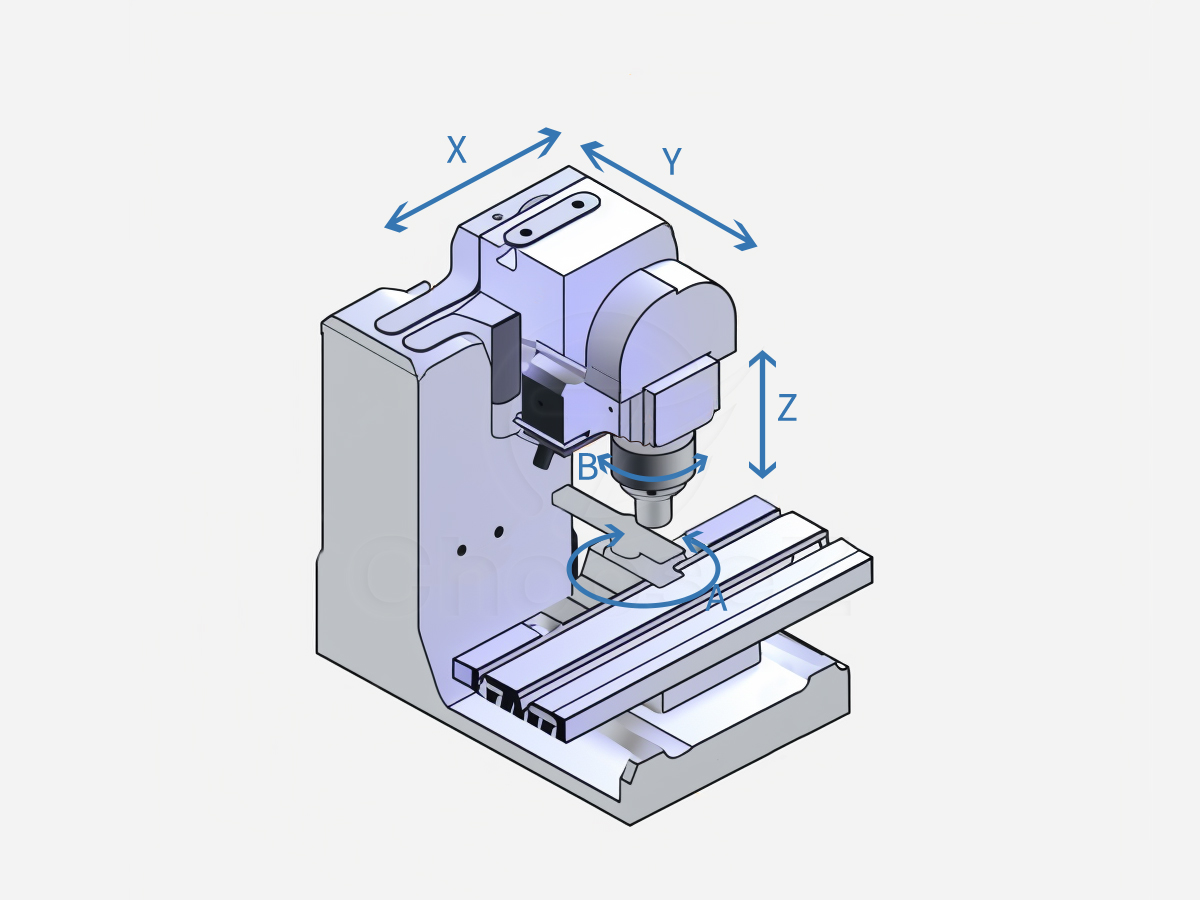
Difference Between 5 Axis, 3+2 Axis, 4+1 Axis CNC Machining
While 5-axis CNC machining involves simultaneous movement in five directions, variations like 3+2 axis and 4+1 axis machining achieve similar complexity through sequential operations. In 3+2 axis machining, the machine uses three primary axes with two additional axes repositioned between operations. Similarly, 4+1 axis machining performs operations with four primary axes and one additional axis. Although not as dynamic as true 5-axis machining, these methods offer enhanced flexibility compared to traditional 3-axis machining.
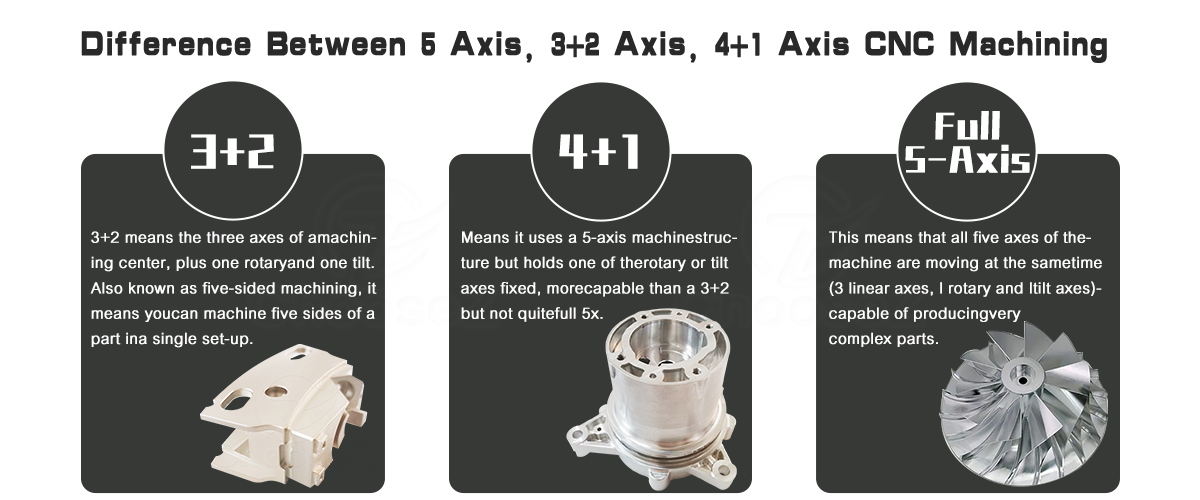
History of 5-Axis Machining
The history of 5-axis machining is a captivating journey marked by technological advancements and a relentless pursuit of precision in manufacturing. Here are key milestones in the development of 5-axis machining:
Early Concepts (19th Century):
The roots of multi-axis machining can be traced back to the 19th century when inventors explored ways to enhance machining processes. However, true 5-axis machining as we know it today was still a distant vision.
Aerospace Innovations (20th Century):
The aerospace industry played a pivotal role in driving advancements in machining. The need for intricate and aerodynamic components led to the exploration of multi-axis capabilities to achieve complex geometries.
Computer Numerical Control (CNC):
The advent of CNC technology in the mid-20th century revolutionized machining. It provided the foundation for precise control over multiple axes, laying the groundwork for the development of 5-axis machining.
Rise of CAD/CAM (Computer-Aided Design/Computer-Aided Manufacturing):
The integration of CAD/CAM systems further propelled 5-axis machining. These systems allowed engineers to design intricate 3D models, which could be seamlessly translated into precise toolpaths for 5-axis machines.
Industry Adoption (Late 20th Century):
As technology matured, 5-axis machining gained broader acceptance across industries. Automotive, medical, and mold-making sectors, among others, began leveraging the capabilities of 5-axis machines for enhanced efficiency and accuracy.
Contemporary Advancements (21st Century):
In recent years, advancements in machine design, control systems, and cutting tools have pushed the boundaries of what 5-axis machining can achieve. Modern machines offer increased speed, accuracy, and versatility.
What Are The Main 5-Axis Configurations?
Trunnion Table Configurations:
Trunnion table setups in 5-axis machines are favored for their resilience and accuracy. Here's a closer look at how this configuration operates:
-The trunnion table, functioning as a rotary table, tilts the workpiece towards the spindle, granting access to multiple facets in a single setup.
-Noted for its stability and support, especially advantageous for machining heavy or sizable workpieces.
-Reduces the necessity for multiple setups, thereby saving time and elevating overall precision.
-Particularly well-suited for intricate components like aerospace parts, emphasizing precision in manufacturing.
Swivel Head Configurations:
Swivel head setups offer an alternative approach to 5-axis machining:
-In this arrangement, the spindle head takes on movement instead of the table, introducing additional axes through swiveling and rotation.
-Provides flexibility in tool positioning and angles, essential for tackling intricate designs and complex geometries.
-Typically faster and more dynamic, making them ideal for detailed and precise work where the tool requires varied angles of approach.
-Preferred for smaller components, capitalizing on a heightened degree of articulation and speed."
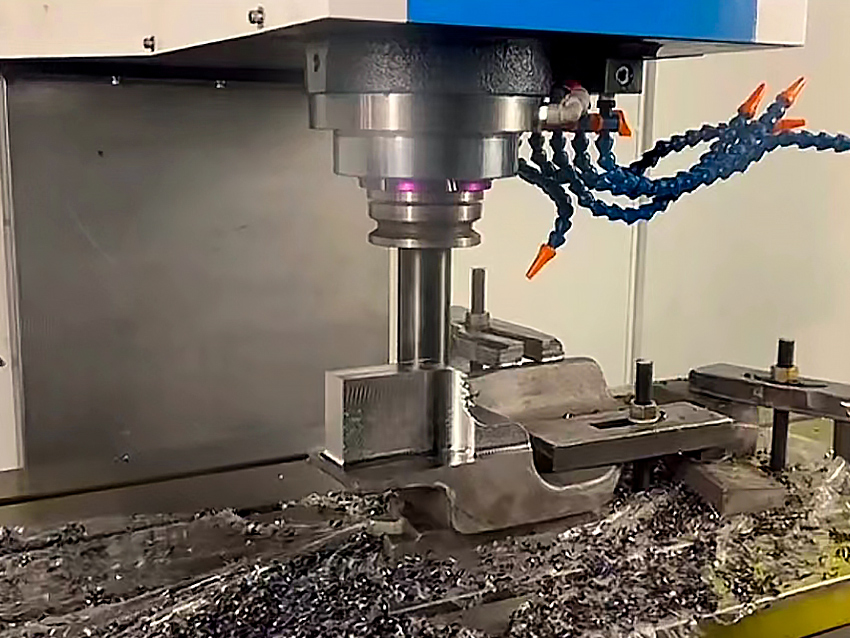
Types Of 5-Axis CNC Machines
Vertical Machining Center (VMC):
In this configuration, the workpiece is fixed on the machine bed, and the tool can move along the X, Y, and Z axes, while the A and B axes provide rotational movement. This structure is suitable for tasks that require high precision, such as mold manufacturing.
Horizontal Machining Center (HMC):
In an HMC, the workpiece is clamped on a rotating worktable, and the tool can move along the X, Y, and Z axes, while the A and B axes provide rotation. This configuration is commonly used for large parts and complex surface machining.
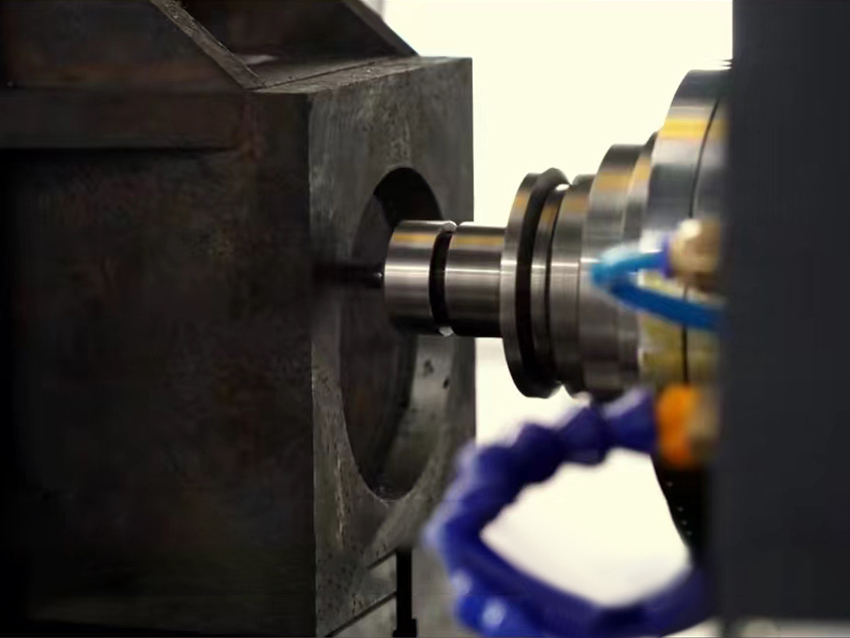

Gantry Machining Center:
Gantry machining centers have a robust structure and are suitable for large workpieces. The worktable moves along the X-axis, the tool moves on a crossbeam, and the A and B axes provide rotation. This configuration is common in the aerospace industry.
Double-Table Machining Center:
In this configuration, there are two worktables that can move relative to each other along the X-axis. The tool can move on the Y and Z axes, while the A and B axes provide rotation. This structure is suitable for efficient production environments with simultaneous loading and unloading.
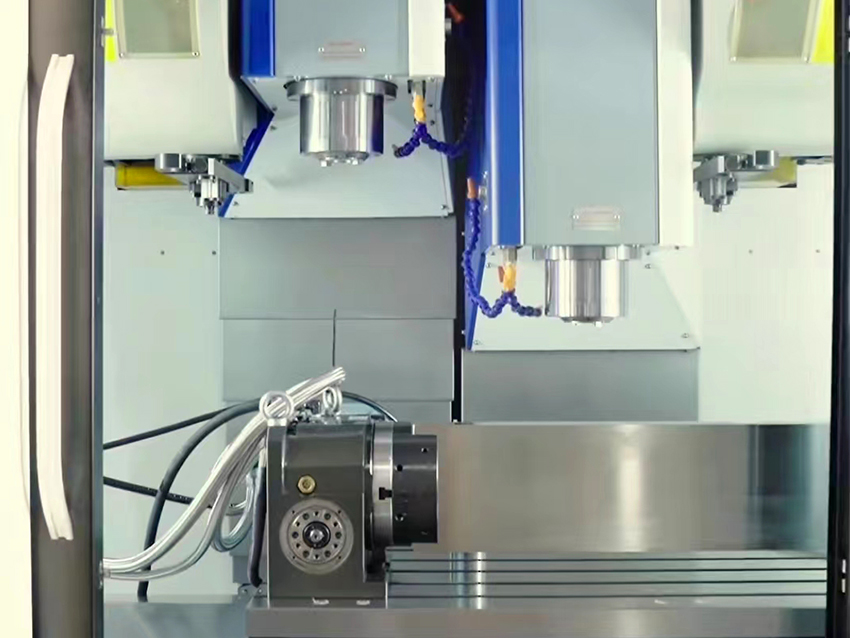

Rotary Machining Center:
Rotary machining centers have a rotating worktable, with the workpiece clamped on the table, and the tool moves along the X, Y, and Z axes. The A and B axes provide additional rotational freedom, making it suitable for multi-sided machining, such as automotive parts
Famous Brands of 5 Axis CNC Machines
The realm of 5-axis CNC machines is enriched by renowned brands known for their innovation and cutting-edge technology. These brands have consistently delivered precision, reliability, and advanced features, making them go-to choices for manufacturers seeking excellence in machining.
Haas Automation:
Haas stands as a stalwart in the CNC machining world, offering a wide range of 5-axis machines. Known for their durability and user-friendly interfaces, Haas machines are prevalent in various industries, from aerospace to automotive.
DMG Mori:
As a global leader, DMG Mori specializes in high-tech machinery, and their 5-axis CNC machines are no exception. These machines are celebrated for their versatility and robust performance, catering to the intricate demands of modern manufacturing.
Makino:
Makino's 5-axis machining centers are synonymous with speed and precision. The brand's commitment to technological advancement is reflected in machines designed to enhance productivity and achieve intricate geometries with utmost accuracy.
Hermle:
Hermle has earned its reputation for producing top-tier 5-axis machining solutions. The brand emphasizes innovation, incorporating cutting-edge features to meet the evolving needs of industries such as medical technology and mold construction.
Okuma:
Okuma's 5-axis machining centers are revered for their high spindle speeds and dynamic capabilities. With a focus on delivering efficient solutions, Okuma machines excel in achieving complex geometries and maintaining superior surface finishes.
FANUC:
FANUC is synonymous with precision and automation. Their 5-axis CNC machines integrate state-of-the-art controls and automation features, making them a go-to choice for those prioritizing efficiency and accuracy.
These brands represent the pinnacle of 5-axis CNC machining, offering a diverse array of solutions to meet the intricate demands of modern manufacturing processes
Programming 5-Axis CNC Machine
Programming a 5-axis CNC machine requires a comprehensive understanding of its intricate movements and capabilities. Unlike traditional 3-axis machines, 5-axis machining introduces additional complexities, but the payoff is the ability to create highly intricate and complex parts. Here's an overview of the key aspects involved in programming a 5-axis CNC machine:
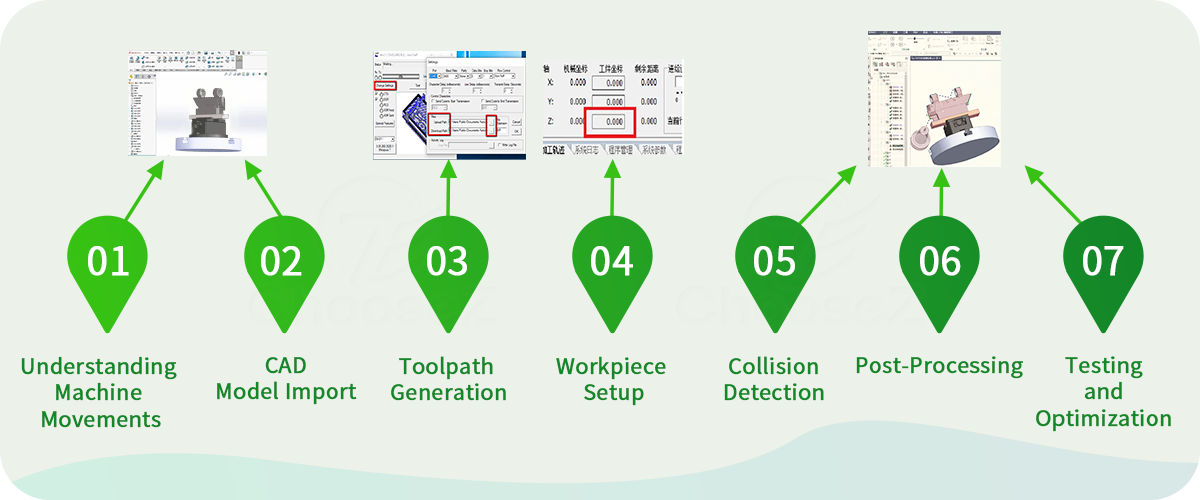
1. Understanding Machine Movements:
Before diving into programming, it's crucial to comprehend how the machine moves in its 5 axes – X, Y, Z, A, and B. The X, Y, and Z axes represent linear movements, while A and B introduce rotational movements. Understanding these movements is foundational to creating precise toolpaths.
2. CAD Model Import:
The programming process often begins with a 3D CAD model of the part. This model serves as the basis for generating toolpaths in the 5-axis space. CAD software capable of handling 5-axis programming is essential for this step.
3. Toolpath Generation:
Generating toolpaths involves creating a virtual path that the cutting tool will follow to machine the part. In 5-axis programming, this includes not only linear paths but also rotations to access different surfaces of the workpiece. CAM (Computer-Aided Manufacturing) software plays a pivotal role in this stage.
4. Workpiece Setup:
Proper workpiece setup is critical in 5-axis machining. This includes defining the workpiece's orientation and origin. Precision in setup directly impacts the accuracy of the final machined part.
5. Collision Detection:
Due to the increased complexity of 5-axis machining, the possibility of tool and machine collisions is higher. Programming must account for potential collisions, and CAM software often includes simulation features to identify and rectify these issues before actual machining.
6. Post-Processing:
Once the toolpaths are generated, the program needs to be post-processed to generate specific machine codes (G-codes and M-codes) that the CNC machine understands. Different machines may require different post-processors.
7. Testing and Optimization:
Before running the full machining operation, it's advisable to conduct simulations and test runs to ensure the accuracy of the program. This step allows for optimization, minimizing the risk of errors during actual production.
Common Fixtures and Inspection Tools in 5-Axis CNC Machining
Efficiency and precision in 5-axis CNC machining are anchored in well-designed fixtures that secure and stabilize workpieces. These fixtures play a vital role in providing access to various surfaces and angles with unparalleled flexibility. To guarantee utmost precision, specialized inspection tools, including Coordinate Measuring Machines (CMM), lead the way in verifying the accuracy and dimensional consistency of complex geometries. Complemented by high-precision probes and cutting-edge laser scanning technologies, these inspection tools ensure that the final output meets the stringent quality standards demanded by advanced manufacturing.
Costs About 5-Axis CNC Machining
Cost of A 5-Axis CNC Machines
Costs of 5-axis CNC machines vary widely, starting from $30,000 for entry-level models suitable for smaller workshops. Mid-range machines for more complex work fall in the $100,000 to $300,000 range. Industrial-grade, high-precision 5-axis machines for heavy-duty tasks can surpass $500,000.
Cost of 5-Axis CNC Machining Work
The cost of 5-axis CNC machining is influenced by various factors, making it a versatile yet intricate process that caters to diverse project requirements. Several key elements impact the overall cost:
Complexity of Design: The intricacy and complexity of the part design significantly affect the machining cost. Highly intricate components with complex geometries may require more extensive programming and machining time.
Material Selection: The choice of material plays a crucial role in cost determination. Exotic or high-performance materials may be more expensive, impacting the overall machining cost.
Tolerance and Precision: Tighter tolerances and higher precision requirements often result in increased machining time and meticulous toolpath programming, contributing to higher costs.
Tooling Requirements: Specialized tooling may be necessary for certain 5-axis machining operations. The type and complexity of required tooling influence the overall cost.
Batch Size: The quantity of parts being produced affects the economies of scale. Larger production runs may lead to reduced costs per part, while small batch sizes may incur higher costs.
Finishing Requirements: Specific finishing processes, such as polishing or coating, can contribute to the overall cost. Parts requiring intricate surface finishes may involve additional time and resources.
Machine Setup Time: The time required to set up the machine for a particular job influences costs. Complex setups may take longer, impacting the overall machining cost.
To obtain an accurate cost estimate for a 5-axis CNC machining project, it's essential to collaborate closely with a machining service provider. Factors like design complexity, material specifications, and project volume should be thoroughly discussed to ensure a precise and transparent cost evaluation.
Advantages and Disadvantages of 5-Axis CNC Machining
Advantages:
Mastering Complexity: At the core of 5-axis machining is its prowess in maneuvering the cutting tool dynamically from multiple angles. This enables the creation of intricate parts with complex geometries, pushing the boundaries of manufacturing possibilities.
Streamlined Efficiency: By accessing multiple faces of a workpiece in a single setup, 5-axis machining trims down on multiple setups, translating to significant time savings and heightened overall efficiency, especially for intricate components.
Elevated Surface Finishes: The dynamic tool movement ensures seamless transitions between surfaces, resulting in impeccable surface finishes. This proves pivotal in sectors like aerospace and medical, where top-notch surface quality is non-negotiable.
Extended Tool Life: Optimized tool engagement, reducing lateral forces on the tool, contributes to prolonged tool life and diminished wear. This not only ensures consistent quality but also brings about substantial cost savings.
Disadvantages:
Skilled Operator Requirement: Unleashing the full potential of 5-axis machining demands intricate programming skills. The complexity of generating precise toolpaths for multi-axis movements underscores the need for adept programmers, amplifying programming time.
Higher Equipment Investment: The adoption of 5-axis CNC machines entails elevated initial and ongoing costs compared to their 3-axis counterparts. The substantial investment in advanced machinery is a pivotal consideration for businesses.
Skilled Operator Requirement: Proficient operation of a 5-axis CNC machine requires a higher skill set. Skilled operators are indispensable to harness the machine's capabilities fully, ensuring accurate setups and efficient execution.
Workholding Conundrums: With 5-axis machining, fixturing becomes more intricate due to the multitude of possible part orientations. Effectively addressing workholding challenges demands innovative solutions to securely anchor parts.
What parts is 5-axis CNC good at?
5-axis machining, renowned for its advanced capabilities, is exceptionally well-suited for manufacturing parts that demand intricate designs and unparalleled precision. Various types of components leverage the unique advantages of 5-axis CNC machines, allowing for complex geometries and impeccable surface finishes. Here are some parts that particularly benefit from 5-axis machining:

Complex Surface Parts:
-Traits:
Navigates non-linear terrains with intricate tool mastery.
Conquers geometrical puzzles deemed impossible for 3-axis counterparts.
Dances with high precision in the realm of tight tolerances.
-Applications:
Aerospace dynamos like turbine blades.
Auto enigmas featuring intricate engine components.
Medical marvels flaunting complex shapes and impeccable surfaces.
Discs Parts:
-Traits:
Craves uniform perfection on both of its symmetrical faces.
Weaves intricate patterns and engineers precise holes.
Demands an orchestra of accuracy for a harmonious balance.
-Applications:
Automotive maestros: Brake discs taking the lead.
Mechanical virtuosos: Precision gears and flywheels.
Machinery conductors: Rotational balance virtuosos.
Boxed Parts:
-Traits:
Masters multiple faces in a single choreographed setup.
Obsessed with precision in every nook, cranny, and edge.
Scales from compact boxes to grandiose machine abodes.
-Applications:
Electronic sanctuaries: Housings for cutting-edge devices.
Machining protagonists: Key components of tooling machinery.
Geometric visionaries: Parts with labyrinthine internals and captivating exteriors.
Special-Shaped Parts:
-Traits:
Rebels against convention with a flair for adaptive tool theatrics.
Conceals complex internal tapestries and secret channels.
Basks in the limelight of customization and precision.
-Applications:
Bespoke engineering: Tailored parts for specialized machinery.
R&D voyagers: Prototypes shaping the future.
Artisanal showpieces: Sculptures of precision and detail.
Industries Benefiting From 5-Axis CNC Machining
The transformative capabilities of 5-axis CNC machining reverberate across diverse industries, revolutionizing manufacturing processes and unlocking unparalleled precision. Explore the realms where the multifaceted advantages of 5-axis CNC machining find resonance:
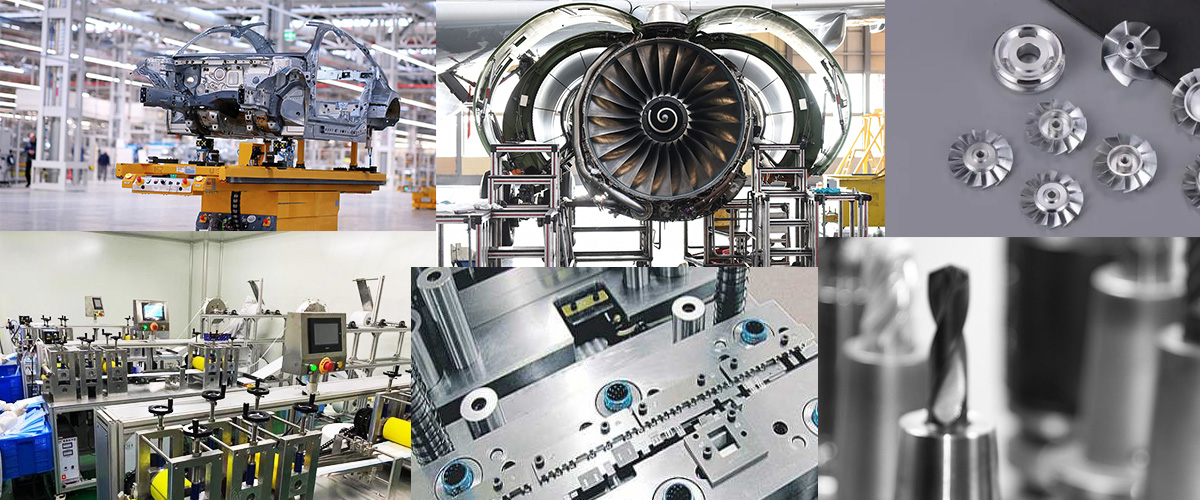
Aerospace Engineering:
Complex Components: In aerospace, where intricate and lightweight components are paramount, 5-axis machining enables the fabrication of precisely contoured parts with reduced material waste.
Medical Device Manufacturing:
Precision Medical Parts: The medical sector benefits from the intricate precision of 5-axis machining, producing complex medical components with stringent tolerances and superior surface finishes.
Automotive Production:
Efficient Prototyping: Automotive manufacturers leverage 5-axis CNC machining for rapid prototyping and the production of complex molds and dies, contributing to streamlined design iterations.
Die and Mold Industry:
Intricate Mold Cavities: Crafting intricate mold cavities with precise geometries is a forte of 5-axis machining, enhancing efficiency and quality in the die and mold industry.
Energy Sector:
Turbine Component Fabrication: The energy sector employs 5-axis machining for the fabrication of intricate turbine components, optimizing performance and efficiency in power generation.
Prototyping and Research:
Iterative Design: In research and prototyping, where precision and speed are crucial, 5-axis CNC machining facilitates the creation of intricate prototypes and research models.
Tool and Die Manufacturing:
Complex Tooling: Tool and die manufacturers harness 5-axis machining to produce intricate tooling, molds, and dies with precise geometries and optimal surface finishes.
Get Started With 5 Axis Machining At ChooseZ
Step into the realm of precision manufacturing with ChooseZ's cutting-edge 5-axis CNC machining services. Our commitment to excellence, coupled with state-of-the-art technology, ensures unparalleled precision and efficiency for your projects.
At ChooseZ, we understand the unique demands of various industries, from aerospace to medical, and deliver tailored solutions. Our skilled machinists harness the power of 5-axis machining to produce intricate components with utmost accuracy.
Why Choose ChooseZ for 5-Axis Machining?
Advanced Technology: Benefit from our cutting-edge 5-axis CNC machines.
Skilled Craftsmanship: Our experienced machinists ensure top-notch precision.
Industry Adaptability: We cater to diverse sectors with customized solutions.
Timely Delivery: Your projects are handled with efficiency and delivered on schedule.
Experience the transformative power of precision with ChooseZ. Elevate your manufacturing capabilities – choose ChooseZ for 5-axis CNC machining.
You Might also Like
View all →
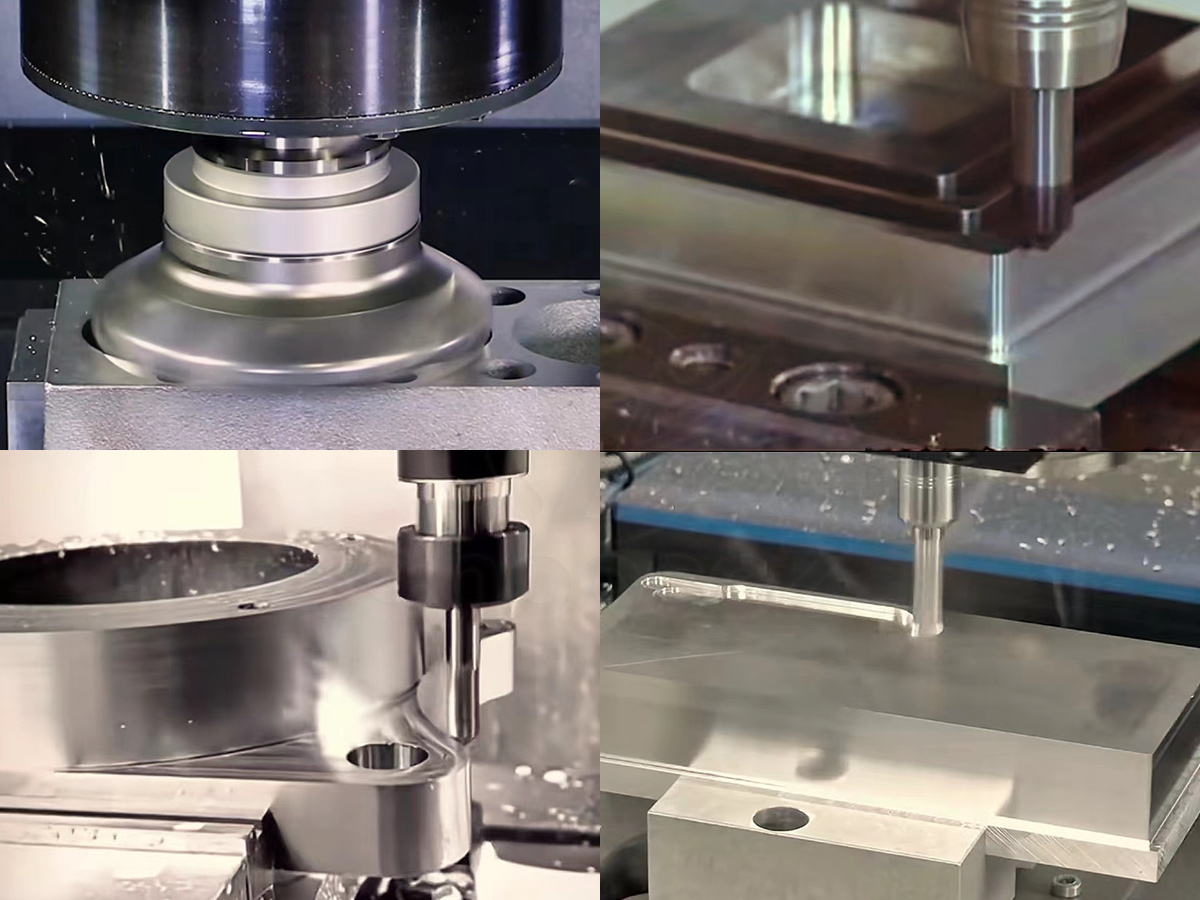
CNC Milling Machine Operation: Ready to Master the Key Skills?
Read More →
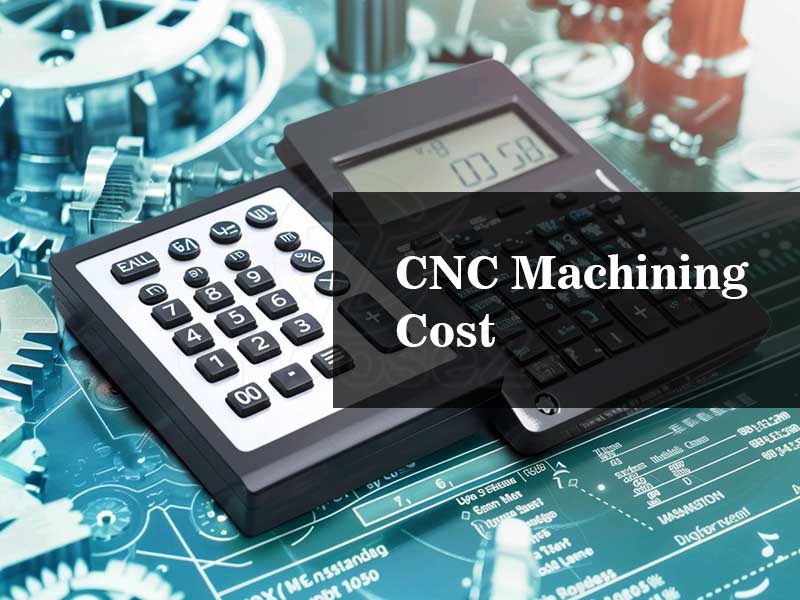
How Much Does CNC Machining Cost?
Read More →





